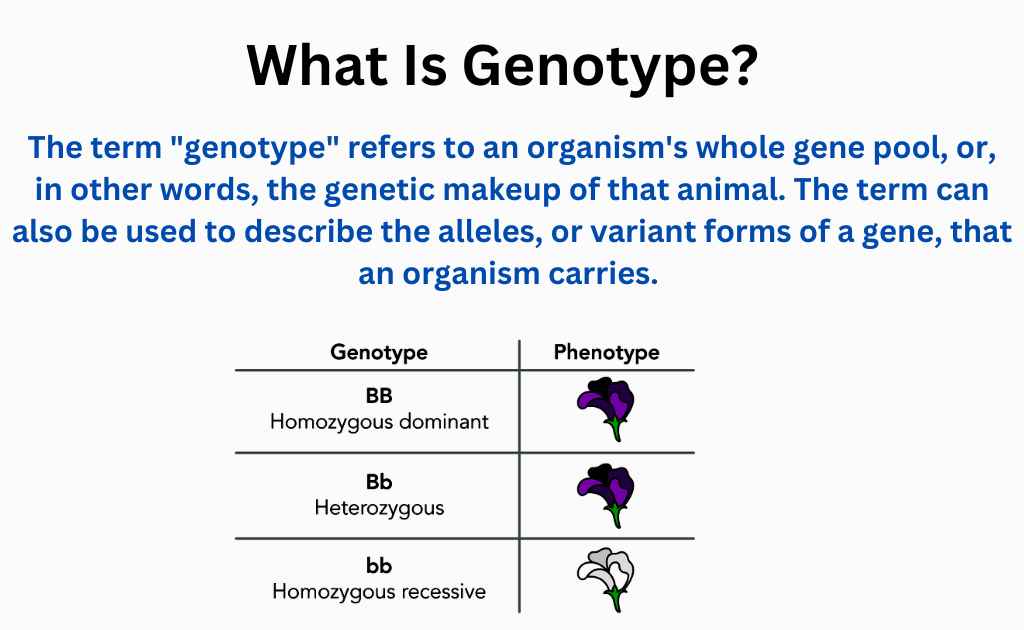What Is Genotype?-How Is It Determined?
The term “genotype” refers to an organism’s whole gene pool, or, in other words, the genetic makeup of that animal. The term can also be used to describe the alleles, or variant forms of a gene, that an organism carries.
As humans are diploid organisms, each locus, contains two alleles, one of which was inherited from each parent. The genotype of a particular gene is represented by each pair of alleles.
Ploidy refers to how many copies of each chromosome are present in that species. It establishes the maximum number of alleles a person can have for a specific gene. Since humans are diploid (having two complete sets of chromosomes), each individual has two alleles for each gene.
When both alleles are the same, the genotype is said to be homozygous. When there are two different alleles, the genotype is said to be heterozygous.

Relation Between Genotype And Phenotype
The phenotype of an individual that is impacted by genotype. Genetics can have varying degrees of influence on phenotype, depending on the characteristic. For instance, a pea plant’s petal color is solely determined by genotype.
The petals of the pea plant can be either purple or white depending on the alleles present. Other characteristics, however, are only somewhat influenced by genotype. These characteristics are sometimes referred to as complex characteristics since they are influenced by additional factors, such as environmental and epigenetic impacts.
Even those with the same genotype do not all look or act the same because appearance and behavior are influenced by the environment and circumstances of growing up. Like how not all organisms with comparable looks share the same genotype.
What Is Genotyping?
The process of genotyping involves figuring out a person’s genotype. The evaluation of genotypes can be done using a variety of methods. Typically, the genotyping approach is determined by the type of data being sought. The DNA sample must first be amplified for many procedures, which is frequently accomplished using PCR.
Chromosomal microarrays are used to check for significant chromosomal duplications or deletions, and karyotyping is also used to count the number of chromosomes an individual possesses.
Exome sequencing can provide more in-depth information. It reveals the precise sequence of every DNA molecule in the genome’s coding region, or whole genome sequencing, which sequences the complete genome including the non-coding section.
How To Determine Genotype?
One of the easiest methods for determining genotype is the Punnett square. To ascertain the probable genotype of an offspring with respect to a specific trait, the square is essentially a little chart.
There are four potential gene pairings in a straightforward Punnett square with a single characteristic. The likelihood of homozygous green peas in the pea example is 1:4, as only one of the four squares has the yy genotype. Because two of the four squares contain the Yy genotype, the likelihood of the heterozygous green-yellow genotype is 2:4.
Latest Research In Field of Genotype
- GEAs are used to identify adaptive alleles in plant biology. Researchers scan genomes for genotype-environment associations, testing the hypothesis that allelic variation at a gene is adapted to local environments. The rise of genomics and new computational approaches facilitate this research, but important questions remain about interpreting GEA findings. [1]
- Scientists have made recent advances in plant transformation technologies using morphogenic transcription factors (MTFs) like Baby boom and Wuschel2 to enhance plant transformation efficiency and expand the range of amenable species and genotypes, accelerating functional genomics and crop trait improvements. [2]
- Scientists have reviewed the progress of phenotype prediction models that use machine learning methods to make accurate predictions from large and complex biological data. They categorized the applications into three scenarios: prediction with genotypic information, with environmental information, and with both. They discuss the practicality, advantages, and challenges of modeling complex relationships, and the potential of developing models that can predict phenotype and interpret the biological consequences of changes in genotype and environment. [3]
- Ankylosing spondylitis (AS) is a chronic inflammatory disease that primarily affects the spine and sacroiliac joints, with a higher prevalence in males. Recent studies have shown that the genetic risk factors for AS vary by sex, highlighting the importance of considering genotype-by-sex interactions in the pathogenesis of the disease. [4]
- A study investigated the effects of genotype and temperatures on proteolytic activity in 48 barley genotypes, including mutants, hulled, hulless, and wild types. Results showed that proteolytic activity declined after 50°C, and was positively correlated with amino acids and negatively correlated with protein content. Four genotypes were identified as having high proteolytic activity and thermostable variants of the enzyme, with potential for use in breeding programs. [5]



Leave a Reply